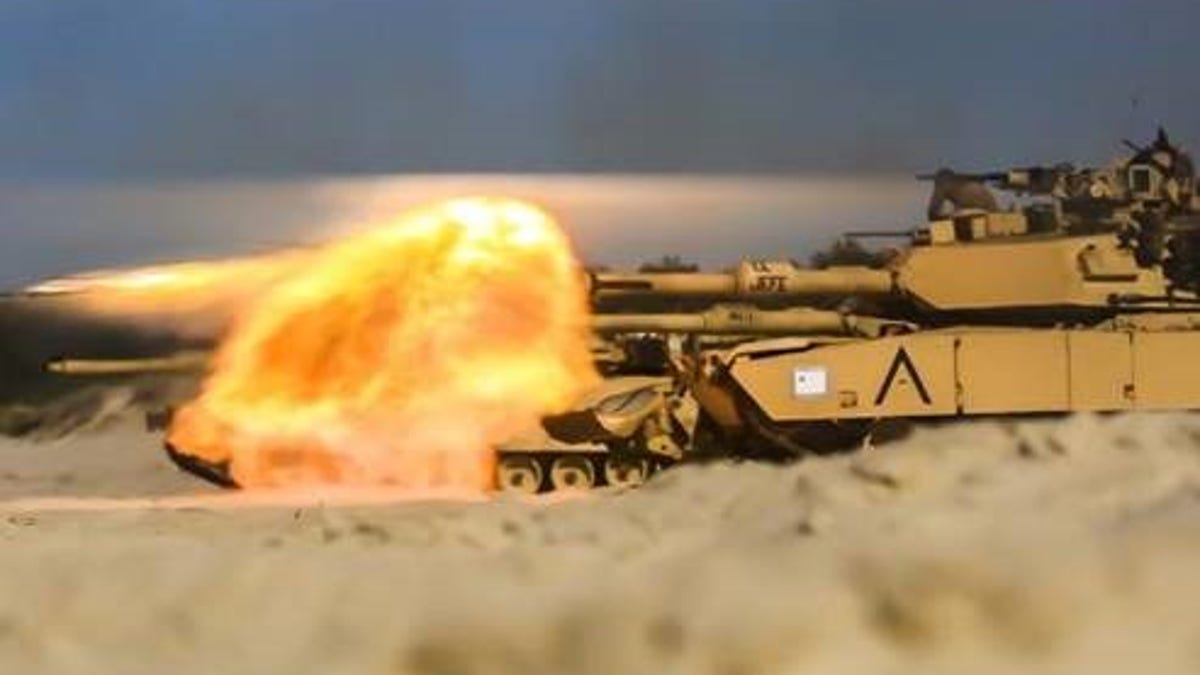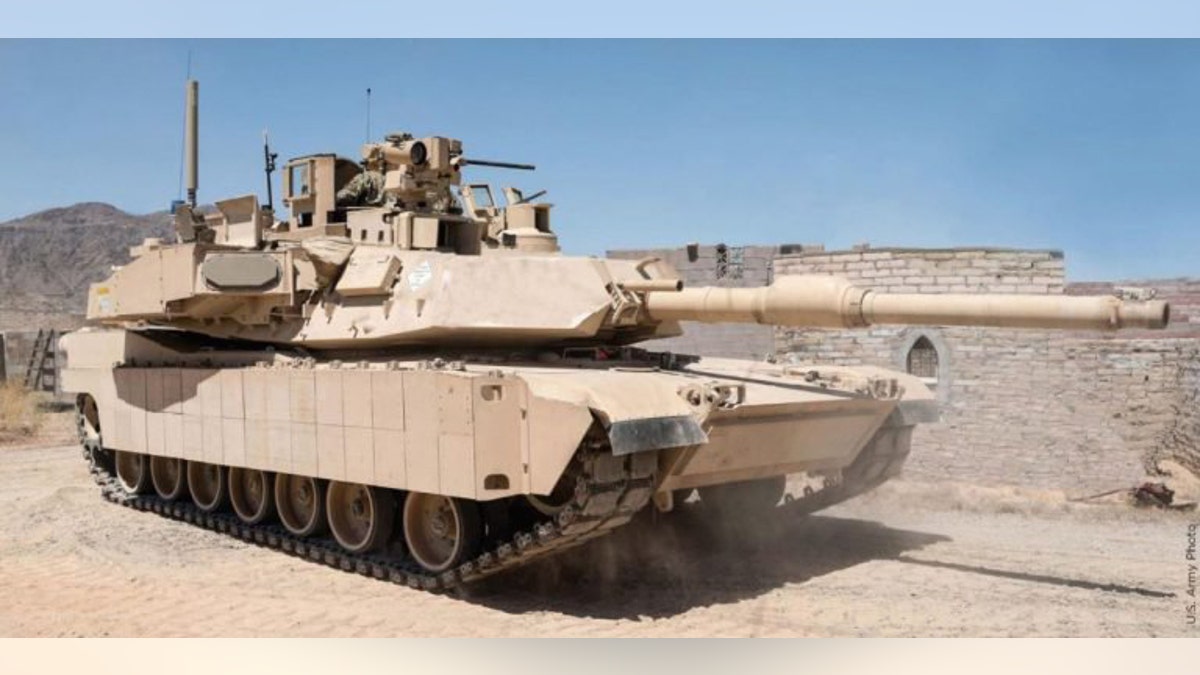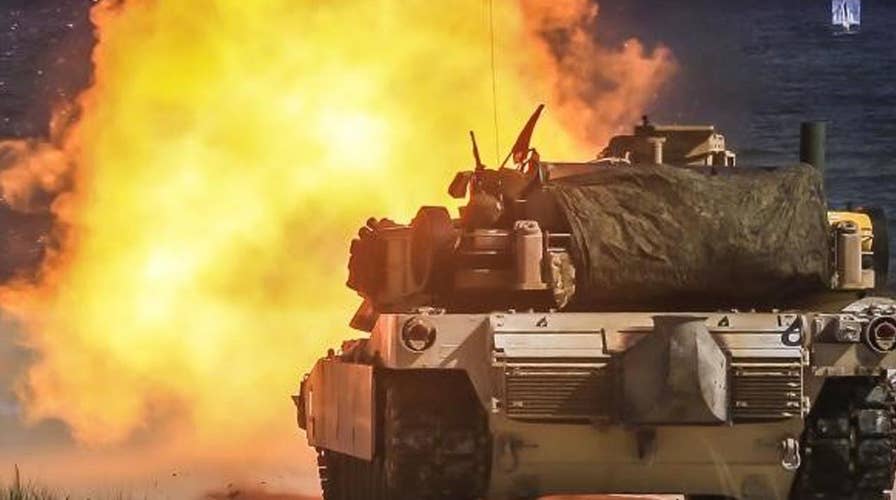'Force field' tech could make US tanks unstoppable
Defense Specialist Allison Barrie has the inside scoop on astonishingly futuristic new technology that creates a seemingly invisible, impenetrable, protective bubble around military armored vehicles.
Astonishingly futuristic new tech creates a seemingly invisible, impenetrable, protective bubble around military armored vehicles making enemy attempts to fire at U.S. tanks pretty pointless – those rounds won’t hit the tank, they’ll explode mid-air.
Think of it almost like making a tank smart enough to defend itself. With the upgrade, tanks automatically protect the crew inside and prevent enemy rounds from making contact with the armor.
Within the blink of an eye, this remarkable technology detects the enemy fire, locates it and launches a response that destroys the threat at a safe distance from the vehicle.
It is sort of like a tiny missile defense system used to protect countries– but one designed to ride along with armored vehicles.
RPGs (Rocket Propelled Grenades) and even Anti-Tank Guided Missiles that can slay tanks are stopped mid-air, precisely intercepted and prevented from hitting the U.S. military tank.
Most types of enemy fire will never reach a tank protected with this tech. It will change warfare forever.
STORMBREAKER: POWERFUL BOMB PENETRATES BAD WEATHER, SPELLS BAD NEWS FOR BAD GUYS
The mind-blowing tech is called Active Protection Systems – or APS.
APS gives soldiers massively better protection, but without adding the weight of additional armor slowing down the vehicles’ speed and maneuverability.

File photo (US Marine Corps)
In the near term, the iconic main battle tank M1 Abrams will be the first to be kitted out with this remarkable new approach to keeping crews safe. The M2 Bradley Infantry Fighting Vehicles and Strykers are also expected to receive this remarkable upgrade soon as well.
Imagine the U.S. Army being able to send vehicles into battle that enemy forces cannot hit with their weapons. Every time they try, the tank automatically launches counter-measures destroying the would-be tank-slaying-round mid-air.
Enemy fire would be futile. The U.S. Army would be even more unstoppable.
Right now, two countries already have battle-proven APS: Russia and Israel.
BLACK HAWK ARMY HELICOPTERS GET FUTURISTIC NEW COCKPIT
The United States defense industry has lagged behind on developing this futuristic method of shielding. To find a solution, the U.S. Army selected three companies to collaborate and adapt their battle-tested tech for U.S. military vehicles. The Israeli company Rafael’s Trophy system used by the Israel Defense Forces is being adapted for the Abrams and the Iron Fist from the Israeli IMI Systems for the Bradley. American company Artis’ Iron Curtain has been in development for use on the Stryker.

M1 Abrams tank with Trophy system (US Army)
In amazing news for Army families and soldiers, General Mark Milley recently told the Senate the Army intends to ultimately outfit the entire heavy force, all combat vehicles, with APS.
WHAT DOES IT STOP?
Basically, APS can stop weapons that are extremely destructive. Weapons that can potentially be lethal to tanks and other armored combat vehicles, even though they are protected by armor.
The APS “shields” could protect U.S. forces from light antitank weapons, guided missiles and rocket-propelled grenades.
Thus far, not every single weapon any enemy could wield would be stopped – but certainly many of the most commonly used would be stopped before impact.
This current generation of APS is very effective against lower-velocity explosive rounds fired by enemy aircraft and ground forces.
HOW WILL IT PROTECT ABRAMS TANKS?
The U.S. Army has awarded a $193 million APS contract to Leonardo DRS to protect the new M1A2 Abrams tanks. The Israel Defense Forces has been using Trophy to protect its Namer heavy infantry fighting vehicle.
ARMY'S NEW MACHINE GUN WILL BLAST LIKE BATTLE TANKS
This APS Trophy uses a number of radars positioned around the tank. The radars help provide 360-degree detection of incoming fire.
Around the clock, the radar scans the entire perimeter out to its maximum range. When a threat penetrates this monitored area, Trophy automatically detects and classifies that threat. Breathtakingly fast, its super smart computer works out the correct kill point in space to intercept before the weapon can hit the tank.
Within milliseconds, Trophy has evaluated whether it is a real threat, sends a warning to the crew and nearby forces and also launches an EFP (Explosively Formed Projectile) to destroy the projectile.
The counter-measure intercepts the incoming, say RPG, and collides with it mid-air at a safe distance from the vehicle.
Translation – threats cannot penetrate Trophy’s protection, keeping the tank and crew safe from strikes that could have been lethal.
It is important to note that Trophy differentiates between serious and non-serious threats. For example, if a tank is rolling through a town and a child throws a rock at it – Trophy will not fire at, and destroy, the rock.
SO WHAT DOES IT FIRE?
Insiders call it a “hard kill” approach to stopping incoming threats.
INNOVATIVE PROJECT HARNESSES LEGOS AND SMARTPHONES IN THE FIGHT AGAINST INVISIBLE, DEADLY WEAPONS
The interceptors are launched from the top of the tank. With Trophy, the interceptors are a series of small, shaped charges.
Trophy fires the small explosives at a specific point in space to exactly intercept and destroy the incoming enemy round.
PODCAST: “NO ONE IS COMING, IT’S UP TO US” – HEAR THIS NAVY SEAL’S MOST AMAZING ADVENTURES
EXPOSING CONCEALED ENEMY ATTACK POSITIONS
Not only does the Trophy system stop the incoming rounds, it also pinpoints the position of the enemy firing at the tank. Trophy figures out the threat’s trajectory in order to successfully intercept the threat. Part of these calculations involves Trophy figuring out the incoming round’s point of origin.
Trophy can instantly relay this location to the force, enabling quick targeting to stop the source of the threat as well.
By doing so, Trophy provides an additional advantage. It rips away the enemy’s ability to conceal themselves. For example in an urban setting, once an enemy combatant fires an RPG from his hidden position in a building, the location will be exposed to the entire force by Trophy. The Army can quickly respond - and it will be the last time that enemy combatant ever tries to kill U.S. forces.
BRADLEYS AND THE IRON FIRST LIGHT
Trophy is not necessarily compatible with all U.S. Army combat vehicles. Power, size and weight are three key challenges to adapting APS to U.S. military vehicles.
Active Protection Systems rely on lots of power and can be rather heavy. A Bradley has less power available than a tank and a cumbersome, heavy APS could undermine the Bradley speed and maneuverability that soldiers rely on.
THIS ORANGE, SQUISHY BODY ARMOR MATERIAL COULD SAVE LIVES
The Army selected IMI’s Iron Fist for adaptation to the M2 Bradley infantry fighting vehicles.
General Dynamics is collaborating with IMI Systems to provide Iron Fist Light. Potentially this APS could be used to upgrade protection not just on the Bradley’s, but other vehicles, even light 4x4 vehicles.
Like Trophy, it is designed to provide 360-degree protection. Iron Fist Light finds threats two ways: a search and track radar and a staring infrared sensor. It detects hostile fire and small arms ammunition burst.
Iron Fist Light fires a small warhead to intercept the threat at a safe distance from the vehicle. It either destroys it or a shock-wave effect defeats it.
DANGER TO DISMOUNTED TROOPS?
Stopping incoming fire from ever hitting a tank is awesome to protect the crew inside- but what about the dismounted troops nearby? Will the explosion of the missile or RPG at a safe distance from the tank have the consequence of putting boots on the ground at increased risk?
It is vital that soldiers near armored tanks are not put in further danger due to protection of the vehicles with APS. The explosion caused by the interceptor hitting the enemy round could result in threats like shrapnel raining down on dismounted troops.
Active Protection Systems definitely pose a challenge, but solutions are available. The U.S. military will need to evolve and consider how they need to adapt tactics, techniques and procedures to the deployment of this futuristic technology. In fact, clever adaptation could lead to dismounted troops near armored vehicles gaining enhanced protection and becoming safer than ever before too thanks to this tech.
Thus far, it seems as though Israel and Russia have largely been able to adapt, so solutions are readily available. If Russia can adapt, then the U.S. military most certainly can as well.
WHAT’S NEXT?
Right now, take the hypothetical extreme scenario of the U.S. forced to engage in battle against Russia. The U.S. Army would face armored vehicles that are protected by advanced APS – as in, protected by these amazing futuristic shields.
If the Russian military fired accurately on the U.S. Army vehicles, then the U.S. Army vehicles would be hit by potentially lethal rounds without APS to shield them.
If the U.S. Army responded by targeting the Russian vehicles firing missiles and RPGs at them, then the American rounds could be ineffective. Russia’s APS could potentially stop U.S. lethal rounds from ever making contact with Russian APS protected vehicles.
General Milley recently updated the Senate that within 24 months Active Protection Systems will be ready for operational use. Currently, there is only budget for four brigades to receive this life-saving, futuristic shield.
Artis’ Iron Curtain is the only U.S. APS under consideration with the U.S. Army right now for the Stryker.
Ultimately, the entire heavy force, all of the U.S. Army ground vehicles, including all the tanks, current combat vehicles and future combat vehicles will be ramped up with active protective systems. Down the line, Humvees, JLTVs and even U.S. Army helicopters might be outfitted with this remarkable tech.





















